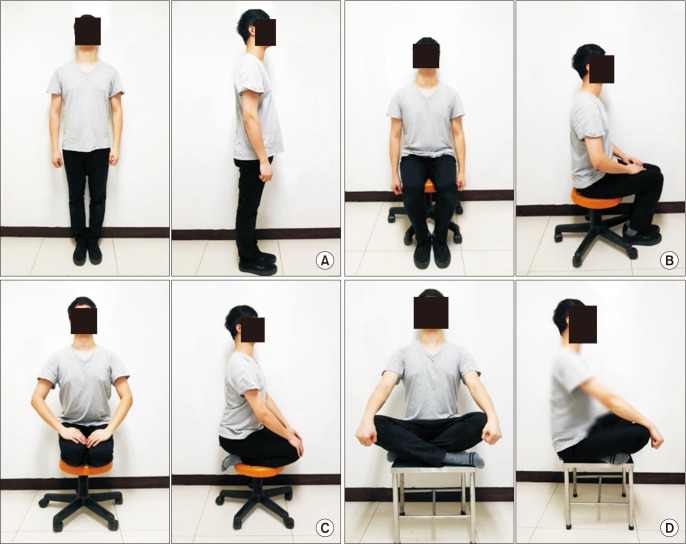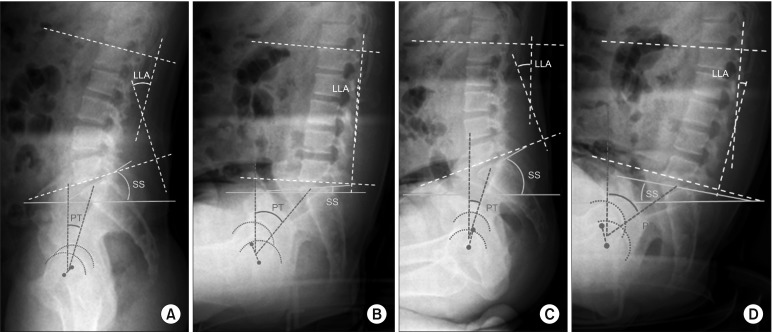Clin Orthop Surg.
2018 Sep;10(3):322-327. 10.4055/cios.2018.10.3.322.
Spinopelvic Orientation on Radiographs in Various Body Postures: Upright Standing, Chair Sitting, Japanese Style Kneel Sitting, and Korean Style Cross-Legged Sitting
- Affiliations
-
- 1Department of Orthopedic and Traumatic Surgery, Cheju Halla General Hospital, Jeju, Korea. mdleeho@hanmail.net
- KMID: 2418752
- DOI: http://doi.org/10.4055/cios.2018.10.3.322
Abstract
- BACKGROUND
Several previous studies reported on the impact of upright standing and chair sitting on the sagittal spinopelvic alignment. However, there are no studies on the impact of the two Asian (Korean and Japanese) style floor-sitting positions on the sagittal spinopelvic alignment. The purpose of this study was to evaluate the impact of four different body postures (standing, chair sitting, kneel sitting, and cross-legged sitting) on the sagittal spinopelvic alignment.
METHODS
Sixteen selected healthy volunteers (10 males and six females) were subjects of this pilot study. In all subjects, radiographs were taken in comfortable standing and sitting positions. All spinal curvatures including lumbar lordotic angle (LLA), sacral slope (SS), pelvic tilt (PT), and pelvic incidence (PI) were measured on the radiographs.
RESULTS
In standing position, the average LLA, SS, PT, and PI were 37.1°, 35.3°, 15.7°, and 51.0°, respectively. In chair sitting, the average LLA, SS, PT, and PI were 17.9°, 20.3°, 28.2°, and 49.5°, respectively. In kneel sitting (Japanese style), the average LLA, SS, PT, and PI were 31.8°, 38.3°, 14.2°, and 52.5°, respectively. In cross-legged sitting (Korean style), the average LLA, SS, PT, and PI were 9.8°, 13.4°, 38.3°, and 51.7°, respectively. LLA in standing (37.1°) and kneel sitting (31.8°) were very similar. Remarkable reduction in LLA was observed in Korean-style cross-legged sitting (9.8°), and LLA in chair sitting (17.9°) was about half of that in standing. SS was similar in standing (35.3°) and kneel sitting (38.3°), and it was reduced remarkably in cross-legged sitting (13.4°). PT was largest in cross-legged sitting (38.3°), and it was similar between standing (15.7°) and kneel sitting (14.2°). PIs were similar in all positions.
CONCLUSIONS
The kneel sitting position did not show significant differences with the standing position when assessed using four parameters related to the sagittal spinopelvic alignment, whereas chair sitting and cross-legged sitting positions significantly altered the spinopelvic alignment compared to the standing position.
Keyword
MeSH Terms
Figure
Reference
-
1. Lord MJ, Small JM, Dinsay JM, Watkins RG. Lumbar lordosis: effects of sitting and standing. Spine (Phila Pa 1976). 1997; 22(21):2571–2574. PMID: 9383867.2. Jackson RP, Peterson MD, McManus AC, Hales C. Compensatory spinopelvic balance over the hip axis and better reliability in measuring lordosis to the pelvic radius on standing lateral radiographs of adult volunteers and patients. Spine (Phila Pa 1976). 1998; 23(16):1750–1767. PMID: 9728376.
Article3. Jackson RP, Hales C. Congruent spinopelvic alignment on standing lateral radiographs of adult volunteers. Spine (Phila Pa 1976). 2000; 25(21):2808–2815. PMID: 11064527.
Article4. Philippot R, Wegrzyn J, Farizon F, Fessy MH. Pelvic balance in sagittal and Lewinnek reference planes in the standing, supine and sitting positions. Orthop Traumatol Surg Res. 2009; 95(1):70–76. PMID: 19251240.5. Endo K, Suzuki H, Nishimura H, Tanaka H, Shishido T, Yamamoto K. Sagittal lumbar and pelvic alignment in the standing and sitting positions. J Orthop Sci. 2012; 17(6):682–686. PMID: 22915074.
Article6. Lazennec JY, Brusson A, Rousseau MA. Lumbar-pelvic-femoral balance on sitting and standing lateral radiographs. Orthop Traumatol Surg Res. 2013; 99(1 Suppl):S87–S103. PMID: 23375267.
Article7. Jackson RP, Kanemura T, Kawakami N, Hales C. Lumbo-pelvic lordosis and pelvic balance on repeated standing lateral radiographs of adult volunteers and untreated patients with constant low back pain. Spine (Phila Pa 1976). 2000; 25(5):575–586. PMID: 10749634.
Article8. Roussouly P, Berthonnaud E, Dimnet J. Geometrical and mechanical analysis of lumbar lordosis in an asymptomatic population: proposed classification. Rev Chir Orthop Reparatrice Appar Mot. 2003; 89(7):632–639. PMID: 14699309.
- Full Text Links
- Actions
-
Cited
- CITED
-
- Close
- Share
- Similar articles
-
- A Comparison Study on the Change in Lumbar Lordosis When Standing, Sitting on a Chair, and Sitting on the Floor in Normal Individuals
- The Effect of Standing and Different Sitting Positions on Lumbar Lordosis: Radiographic Study of 30 Healthy Volunteers
- The Effects of Prolonged Sitting in a Cross-legged Posture on Pulmonary Function in Young Adults
- Internal Oblique and Transversus Abdominis Muscle Fatigue Induced by Slumped Sitting Posture after 1 Hour of Sitting in Office Workers
- Seat Pressure Distribution Characteristics During 1 Hour Sitting in Office Workers With and Without Chronic Low Back Pain



